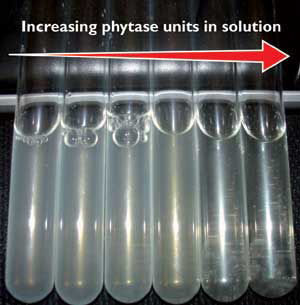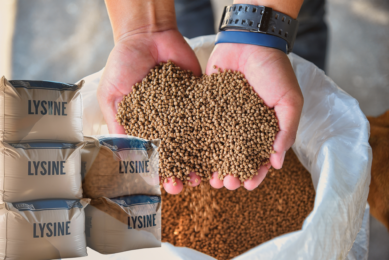Choosing a phytase to maximise performance and profit

At a time of exceptionally high feed costs it is only natural that livestock producers should look for ways to reduce diet and overall production costs. Phytase is the most widely used feed enzyme in the world and is recognised for the benefits it brings in reducing diet costs, at the same time as protecting the environment from excessive phosphorus pollution. However the question still remains of whether new, improved sources of phytase are being fully exploited by the feed industry at a time of rising and volatile feed prices.
By Dr Gary Partridge, Development & Technical Director, Danisco Animal Nutrition, UK
Phosphorus is essential to support the animal’s physiological processes for maintenance and growth. Unfortunately, most dietary phosphorus in vegetable raw materials exists in the form of phytate (inositol phosphate-6; IP6). This complex structure is how plants store phosphorus and it is present in all plant-based feed ingredients. Animals cannot digest phytate to any significant extent and can therefore only utilise a small proportion of the phosphorus contained in these raw materials. Adding phytase to feed overcomes this limitation.
Phytate is also an ‘anti-nutrient’ that binds to proteins and other essential nutrients, making them less available to the animal. Not only is this inefficient and expensive in terms of ‘lost’ nutrient value, but phytate also causes the animal to waste energy and protein/amino acids by stimulating excessive endogenous secretions in the gut. The net overall effect is an adverse impact on animal performance and profitability. Less well appreciated, however, are the considerable differences in bio-efficacy which exist between various phytase sources and their consequent impact on livestock performance.
Importantly, the nutrient binding effects of phytate vary according to the pH level of the gut. Phytate binds with proteins/amino acids more easily at lower pH levels typically found in the stomach and gizzard where phytate forms stable phytate-protein complexes. At the higher pH levels found further down the intestinal tract, phytate has a greater affinity for minerals. The total anti-nutrient effect, i.e. combined with the energy and protein/amino acid loss due to excessive endogenous secretions, is often known as the ‘phytate effect’. An understanding of the ‘phytate effect’, and the impact of pH on phytate’s nutrient binding properties, is the first step in being able to maximise return on investment when choosing a phytase enzyme.
Phytase as an enzyme acts specifically on phytate, breaking its bonds with nutrients, thereby releasing phosphorus, amino acids and energy. On a basic level, using phytase reduces the need to add expensive inorganic phosphorus to the diet, therefore reducing feed costs. However, the additional nutrient contributions which phytase makes to the diet can be a source of extra profit by enabling the nutritionist to reduce both energy and amino acids in the diet formulation, without loss in animal performance. Also, the nutrient contribution of phytase varies depending on the initial phytate concentration in the raw materials, the amount of phytase added, and the bio-efficacy of that phytase. Higher phytate concentrations in raw materials therefore result in better value from including phytase and, at times of particularly high raw material prices, higher doses of phytase can also bring more additional net value.
As phytase reduces the need for supplemental inorganic phosphate in the diet, at the same time as improving the utilisation of amino acids and energy, it also has positive effects on the environment by reducing nutrient excretion in manure.
Phytase differences
Producers who already include phytase in their diets for its phosphorusreleasing benefits, often include the enzyme at insufficient levels to maximise its additional energy and amino acid-releasing benefits. Others are still using traditional fungal phytases rather than new-generation products (e.g. E.coli-derived) which differ fundamentally in terms of their properties and bio-efficacy e.g. research carried out at Schothorst Feed Research has indicated that an E-coli derived phytase (Phyzyme XP, Danisco Animal Nutrition) was on average 67% more bio-efficacious than a traditional fungal phytase.
The main difference between the traditional fungal and E.coli phytases is the rate and extent of phytate breakdown in the digestive tract, particularly at low pH. The more efficient E.coli phytases have a faster rate and more complete breakdown of the phytatenutrient bonds than the traditional fungal phytases. Despite the widely accepted knowledge of the differences in activity between traditional fungal and E.Coli phytases, it’s less well recognised that differences also exist between the commercially available E. coli phytase products.
The development, by Danisco Animal Nutrition, of a new in vitro assay method has enabled the efficacy of different phytases against the anti-nutrient effects of phytate to be more accurately assessed. By better understanding phytate chemistry and how different phytases work, nutritionists can effectively apply phytase as a strategy to further minimise feed costs and improve production efficiency.
An in vitro trial by Tran et al (2011) investigated the activity of different commercial phytases at pH 3.0 and 37°C against the anti-nutrient effects of phytate-protein complexes. Compared to a conventional phytase assay, this more closely simulates in vivo conditions by using pH 3.0 instead of pH 5.5, and uses a phytate-protein complex (IP6-soy protein) as a substrate instead of ‘conventional’ sodium phytate. The data generated can be seen as more physiologically and practically relevant. The trial found that under these pH and temperature conditions, close to those found in the upper part of the animal’s digestive tract, E.coli phytases showed higher relative activity in hydrolysing IP6 in the IP6-soy protein complex than IP6 in the form of sodium phytate. These results also confirmed that E.coli phytases are far more effective than traditional fungal phytases at dealing with the anti-nutrient effects of phytate in the upper part of the digestive tract where phytate exerts its main antinutrient effects.
In addition, Phyzyme XP (E. coli phytase, S.Pombe) showed a relative activity level of 164% on IP6-soy protein substrate whereas a competitor E.coli phytase was 26 percentage units lower. The two fungal phytases had much lower relative activities (Figure 1) against both substrates at this pH (below 40%).
Using this technique Tran et al. also visually demonstrated the binding effect of phytate with proteins, which caused the solution of soy-protein to become cloudy (turbid). Adding phytase to the turbid assay solution broke these bonds, releasing the phytate bound nutrients. The more proteins released, the clearer the assay solution became.
Maximising phytase benefits
Phytate levels in feed raw materials are variable and negatively affect the overall efficiency of nutrient utilisation, resulting in reduced animal performance. Adding a highly efficient, new generation phytase can overcome many of these anti-nutrient effects of phytate. At a time of ever-increasing raw material prices it is particularly important that the value of phytase at different levels of addition in feed formulation is fully understood to maximise feed cost savings.
[Source: Enzyme special]











